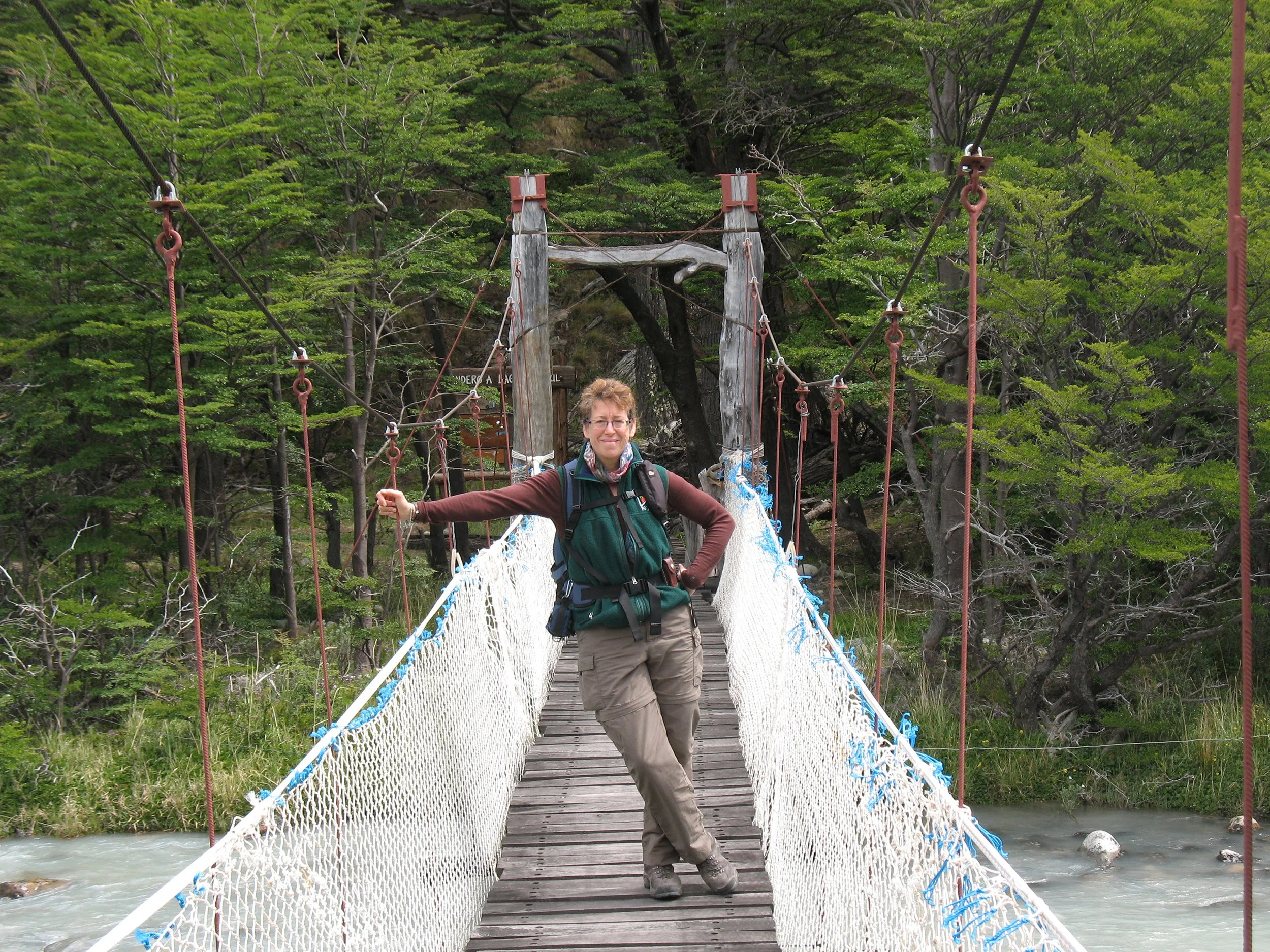Patagonia: Western Hemisphere’s South End
Patagonia. What a beautiful word. My love for the sound and look of it came long before the outdoor-wear company by that name was founded. Patagonia is not a country, but a region at the tip of South America that includes terrain in both Chile and Argentina. It spans the continent from the southern Atlantic Ocean across the Straits of Magellan (claimed by Chile in 1843) to the Pacific side. It delves hundreds of miles inland across the beautiful flatness of the pampas (grasslands), over immense glacial lakes and up the spine of the Andes, then steeply down to the fjords leading out to the Pacific. Years of wishing to see Patagonia firsthand evolved into reality for two weeks in 2010, when I journeyed there with my hiking/adventure buddy, Margaret Idema.
On the way to Torres del Paine Nat’l Park
Wherever you go in Patagonia, it brims with natural beauty and drama. It hosts the world’s second-largest non-polar ice cap. (Fun Fact: the world’s largest non-polar ice cap lies in Canada’s Yukon Territory in the Kluane National Park & Reserve.)
Magellanic penguins heading out to dinner!
Our journey began in the port city of Punta Arenas, Chile. There, our group of six met our Patagonian-born guide T.C. Bahamondez. With T.C. and the other in-country staff from Mountain Travel Sobek, we visited both Torres del Paine (pronounced “Pine-ee”) National Park in Chile and Los Glaciares National Park in Argentina.
Guanaco and her baby
A south view of a choique (or nandu) headed north
On the drive from the coast, we were surprised by the subtle ascension of the Andes over the horizon; one minute, you’re on the level, seemingly endless pampas with hardly a single tree in sight. The next, breathtaking spires and towers and granite and snow and glaciers are just...there. They seem modest enough at first, but the vistas grow quickly with ever-increasing drama.
At Torres del Paine, we took to our feet and headed out to enjoy the celebrated 50-mile “W Hike,” so named for its shape on the map. We trekked via three beech-filled valleys to high ground in search of world-famous views of three sheer granite towers, but we were thwarted by an atypical midsummer snowstorm in Ascension Valley. Our French Valley hike started well, but weather blocked the best views that day, too. On the third spoke of the “W” we hiked long and hard to the base of Grey Glacier, where lucky weather permitted the ferryboat to arrive and take us past glorious views of the four peaks of Paine.
Along the “W” trek
Our first day in Argentina was spent at and upon Perito Moreno Glacier, not far from the town of El Calafate. We got to don crampons and take a hike on the glacier itself. Toward the end, we rounded a corner only to discover that our guides had set up a surprise (and very welcome) cocktail hour featuring Famous Grouse whisky on cubes of glacier ice!
One of our cabins along the way.
Famous Grouse cocktails on the glacier!
Then we headed for the famous climbing and trekking village known as El Chaltén. During the drive, the Andes again rose spectacularly from the pampas. The highest tower, at 11,073 feet, is also named El Chaltén, meaning “the Smokey One.” This beautiful peak has its own microclimate that often leaves it wreathed in clouds—but we saw it! We enjoyed amazing vistas of the striking towers and needles of the Fitzroy massif as it hovered over us during hikes on nearby trails for the next three days.
On the road to El Chalten
Wildlife sightings were wonderfully exotic for us North Americans. We encountered many guanaco, wild relatives of the llama family. Happily, we were there when their very sweet babies were still little and full of spunk! We saw some ostrich-like choique (or nandu), a large flightless bird very similar to the ostrich. They are very fast runners! We even caught sight of some Magellanic woodpeckers, which can be quite elusive, as well as many impressively large Andean condors free and on the wing.
The El Chalten massif.
If you ever go to Patagonia, be prepared for wind! We had our fair share. (On our free day before starting out, Margaret and I went to see a Magellanic penguin colony outside Punta Arenas–and nearly got blown off our feet by the powerful wind!) Wind, I noted in my journal, “is an interesting character in this scenario...you know it’s windy when there are big ripples on little puddles.” Even for a tent addict like me, our reservations at refugios (trailhouses) and hotels were very welcome, thanks to the shelter from that constant and significant force.
In our eleven days in Patagonia, we hiked 48 miles in Chile and 42 in Argentina. Nonetheless, we gained weight, thanks to the amazing hospitality and excellent wines and beers of the region—but that’s another story!
[This blog originally appeared in Susan Smith’s blog, “Design Destinations” in February, 2011. It has been updated and edited.]








